Go Native! Gardening With Native Plants And Wildhlowers In The Lower Midwest
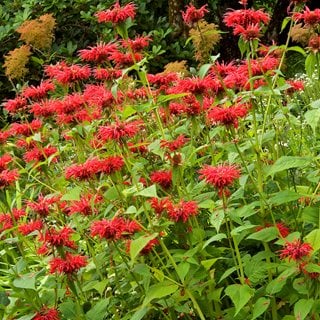
Bee balm plants in a native garden. Photo by: Janet Loughrey.
There's been a lot of buzz in recent years about growing native plants. There are many reasons to add natives to your yard. These plants are easier to care for, provide food and shelter for wildlife, and help to restore the ecosystem.
Some believe that natives aren't attractive, which is simply not the case. By including a variety of natives that bloom at different times and have multi-seasonal attributes, you can have a beautiful natural landscape year-round. Here's how to get started.
On this page: Native Plant Basics | Common Native Plants | Regional Native Plants | Native Garden Design Tips | Native Gardens
On this page:
- NATIVE PLANT BASICS
- COMMON NATIVE PLANTS
- REGIONAL NATIVE PLANTS
- NATIVE GARDEN DESIGN TIPS
- NATIVE GARDENS
NATIVE PLANT BASICS
WHAT IS CONSIDERED A NATIVE PLANT?
Native plants are endemic to a particular area, occurring there long before human habitation. These plants evolved and adapted to the local climate and growing conditions, becoming an integral part of the ecosystem.
WHY ARE NATIVE PLANTS SO IMPORTANT?
Regional wildlife including bees, butterflies, and birds adapted to using native plants as a source of food and shelter. Established meadows and woodlands help impede invasive plants that can take over and upset the balance of nature. Because industrial farming and development has destroyed large swaths of habitat, home gardeners can help by creating natural landscapes that provide a safe haven for wildlife and benefit the environment.
WHY ARE NATIVE PLANTS BETTER?
Native plants are easier on the environment, as they eliminate the need for fertilizers and pesticides, and require little or no supplemental water. Gardeners can reduce their carbon footprint by creating a landscape that is easier to maintain and helps restore balance to the ecosystem. Natives are easier to grow than non-native ornamentals, as they are adapted to that area.
HOW CAN YOU ADD NATIVES TO YOUR YARD?
Adding even just a few native plants to your landscape can go a long way towards supporting wildlife.
- Choose varieties that are native to your particular region. A plant listed as native to the US may grow just fine in Missouri, but not southern California.
- Replace a patch of lawn with a small wildflower meadow.
- Reclaim a part of a perennial border by replacing non-native ornamentals with natives such as bee balm or coneflower.
- Even if you only have a small yard, patio or apartment balcony, you can grow natives in a container.
NATIVE VS. NATIVAR?
The term "nativar" was coined by renowned plantsman Dr. Allan Armitage to distinguish a true native from a cultivar that is derived from a native plant. A nativar can be selected from a naturally occurring trait, mutation, or selective breeding (hybridization) to develop certain traits such as leaf color, variegation, fall color, plant habit, disease resistance, or fruit size.
CAN A NATIVE PLANT BE INVASIVE?
Though most natives are well-behaved, occasionally some can become invasive, especially if introduced to conditions that are more conducive than their original habitat. These can include American bittersweet (Celastrus scandens), goldenrod (Solidago spp.), box elder (Acer negundo) and southern catalpa (Catalpa bignonioides). Invasives vary by region and can change over time due to climate change and other factors.
MORE THAN BEES & BUTTERFLIES
Though gardening natively is most often associated with helping bee and butterfly populations, many other types of wildlife benefit. These include birds, reptiles, amphibians, mammals, and pollinating insects. Native plants also help to restore soil health, reduce erosion, and improve water quality.
COMMON NATIVE PLANTS TO GROW
There are thousands of different plant varieties native to the U.S. that can be grown in home gardens. Here are some of the most commonly grown. Make sure they will do well in your particular area.
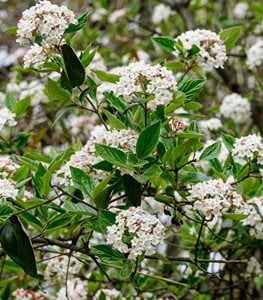
Photo by: Cristina Ionescu / Shutterstock.
ARROWWOOD VIBURNUM (Viburnum dentatum)
Plant type: Shrub
Zones: 2-8
Exposure: Full sun to partial shade
Bloom time: Late spring
Flower color: White
Height/Spread: 6 to 12 feet tall and wide
This sturdy shrub has attractive multi-seasonal interest, with serrated green leaves, white flowers, blue fruit and colorful fall foliage. It attracts a wide range of birds and butterflies and is tolerant of different growing conditions. Use as hedging and shelter for songbirds.
Recommended nativars: Blue Muffin®, Autumn Jazz, Moonglow
Learn more about growing viburnum.
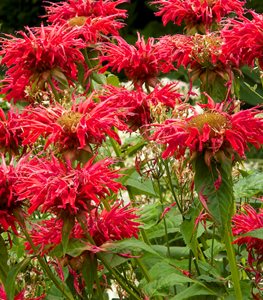
Photo by: Janet Loughrey.
BEE BALM (Monarda spp.)
Plant type: Perennial
Zones: 3-9
Exposure: Full sun to partial shade
Bloom time: Late spring to fall
Flower color: Red, pink, lavender, purple, white
Height/Spread: 2 to 4 feet tall, 2 to 3 feet wide
Flower nectar provides food for pollinating insects, hummingbirds, and butterflies. Seed heads are a food source for birds in fall and winter. The flowers and aromatic leaves have medicinal and herbal qualities.
Recommended nativars: 'Pardon My Cerise', Jacob Cline
See more on growing bee balm.
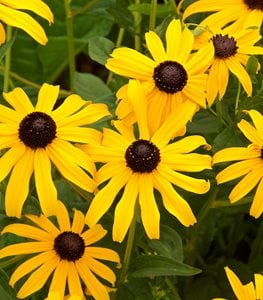
Photo by: Janet Loughrey.
BLACK-EYED SUSAN (Rudbeckia hirta)
Plant type: Perennial
Zones: 3-9
Exposure: Full sun to partial shade
Bloom time: Summer
Flower color: Yellow, gold, orange, or bronze
Height/Spread: 1 to 4 feet tall, 1 to 2 feeet wide
This common prairie native supports butterflies and other insect pollinators. Use in a mixed border or allow to naturalize in a meadow setting.
Recommended nativars: 'Prairie Sun', 'Indian Summer', 'Cherokee Sunset'
See more on how to grow black-eyed Susan.
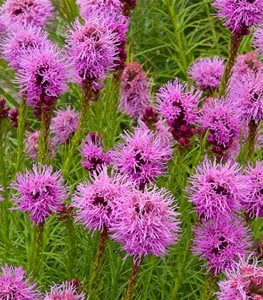
Photo by: Janet Loughrey.
BLAZING STAR (Liatris spicata)
Plant type: Perennial
Zones: 3-9 Exposure: Full sun
Bloom time: Summer to early fall
Flower color: Lavender, pink, purple, white
Height/Spread: 2 to 5 feet tall, 1 to 2 feet wide
Bee appeal: Native to North American prairies, the tall spiky flowers attract butterflies, bees, and other beneficial insect pollinators. This sturdy perennial thrives on neglect and is tolerant of poor soils and heat.
Learn how to grow & care for liatris.
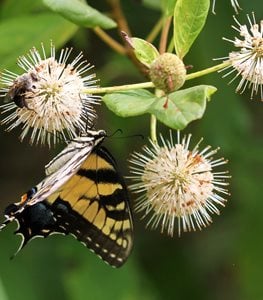
Photo by: Janet Loughrey.
BUTTONBUSH (Cephalanthus occidentalis)
Plant type: Shrub
Zones: 4-9
Exposure: Full sun to partial shade
Bloom time: June to September
Flower color: White
Height/Spread: 6 to 12 feet tall and wide
Recommended nativars: Sugar Shack®, Pink Pong, Keystone
Showy pincushion-like flowers attract butterflies, moths, and other beneficial insects. Native to much of the U.S., this sturdy carefree shrub makes a good substitute in areas where butterfly bush is invasive.
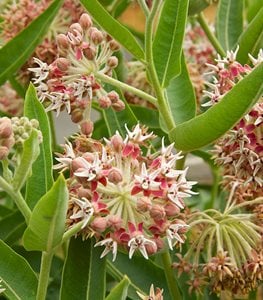
Photo by: Janet Loughrey.
COMMON MILKWEED (Asclepias syriaca)
Plant type: Perennial
Zones: 3-9
Exposure: Full sun to partial shade
Bloom time: Early to mid-summer
Flower color: Pink, lavender, white
Height/Spread: 2 to 5 feet tall, 2 to 3 feet wide
Milkweed leaves are the sole food source for Monarch butterfly caterpillars. Butterfly weed (Asclepias tuberosa) can be substituted. Monarch butterflies are endangered due to habitat loss.
Learn how to grow milkweed plants.
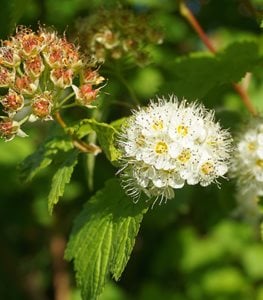
Photo by: Ienic / Shutterstock.
NINEBARK (Physocarpus opulifolius)
Plant type: Shrub
Zones: 2-8
Exposure: Full sun to partial shade
Bloom time: Late spring to summer
Flower color: White or pink
Height/Spread: 3 to 10 feet tall, 3 to 12 feet wide
This sturdy shrub provides four-season interest, with attractive foliage, flowers, berries, and bark. Ninebark provides food and shelter for wildlife and is adaptable to a wide range of soils and growing conditions. Use for erosion control.
Recommended nativars: Summer Wine®, Coppertina, Dart's Gold
Learn how to grow ninebark shrubs.
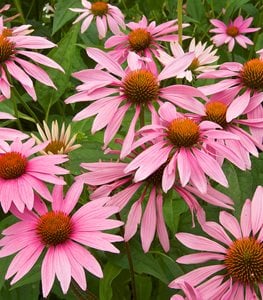
Photo by: Janet Loughrey.
PURPLE CONEFLOWER (Echinacea purpurea)
Plant type: Perennial
Zones: 3-9
Exposure: Full sun to partial shade
Bloom time: Summer to early fall
Flower color: Pink, purple, white, yellow, orange, cream, and red
Height/Spread: 2 to 4 feet tall, 1 to 2 feet wide
The flower nectar of this common prairie native is an important source of nutrients for butterflies and insect pollinators. Seedheads provide food for songbirds during fall and winter.
Recommended nativars: 'Green Envy', Magnus, Fragrant Angel, Lilliput, Avalanche, Ruby Giant
Learn how to grow coneflower.
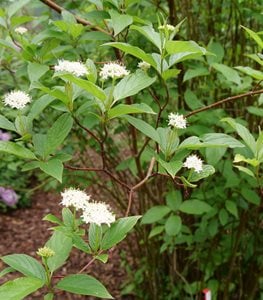
Photo by: Proven Winners.
REDTWIG DOGWOOD (Cornus sericea syn. C. stolonifera)
Plant type: Shrub
Zones: 3-8
Exposure: Full sun to partial shade
Bloom time: Late spring
Flower color: White
Height/Spread: 6 to 9 feet tall, 8 to 12 feet wide
Also known as red osier dogwood, this sturdy shrub with four-season appeal grows in a range of soil conditions and is tolerant of urban pollution. Green or variegated foliage is accompanied by white flowers in spring, followed by white berries, reddish-purple fall foliage and bright red stems that provide winter interest. Use for erosion control.
Recommended nativars: Arctic Fire® Red, Cardinal, Flaviamea, Silver and Gold
Learn more about growing dogwood.
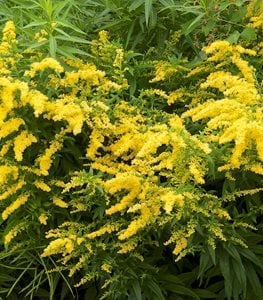
Photo by: Janet Loughrey.
SHOWY GOLDENROD (Solidago speciosa)
Plant type: Perennial
Zones: 3-8
Exposure: Full sun to partial shade
Bloom time: Late summer to early fall
Flower color: Yellow
Height/Spread: 2 to 4 feet tall, 2 to 3 feet wide
Native to much of the eastern and central U.S., this fall bloomer is an important late-season nectar source for migrating Monarch butterflies and other beneficial insects. Naturalize in a cottage-style border or meadow landscape. Can become somewhat aggressive when grown in moist, rich soil.
Learn more about growing goldenrod.
REGIONAL NATIVE PLANTS
| NORTHEAST NATIVE PLANTS | Eastern redbud (Cercis canadensis), foamflower (Tiarella cordifolia), New England aster (Symphyotrichum novae-angliae), serviceberry (Amelanchier spp.), wild ginger (Asarum canadense), Northern maidenhair fern (Adiantum pedatum) |
| SOUTHEAST NATIVE PLANTS | Flowering dogwood (Cornus florida), Southern magnolia (Magnolia grandiflora), pasture rose (Rosa carolina), oakleaf hydrangea (Hydrangea quercifolia), beautyberry (Callicarpa americana), Carolina jessamine (Gelsemium sempervirens) |
| MIDWEST NATIVE PLANTS | Butterfly weed (Asclepias tuberosa), beardtongue (Penstemon spp.), little bluestem (Schizachyrium scoparium), wild bergamot (Monarda fistulosa), spicebush (Lindera benzoin), cardinal flower (Lobelia cardinalis) |
| TEXAS NATIVE PLANTS | Ashe juniper (Juniperus ashei), yaupon (Ilex vomitoria), dwarf palmetto (Sabal minor), Texas sage (Leucophyllum frutescens), Texas sotol (Dasylirion texanum), century plant (Agave americana) |
| ROCKY MOUNTAIN NATIVE PLANTS | Plains prickly pear (Opuntia polyacantha), soapweed yucca (Yucca glauca), Rocky Mountain columbine (Aquilegia caerulea), Colorado four o'clock (Mirabilis multiflora), threadleaf giant hyssop (Agastache ruprestis), Rocky Mountain penstemon (Penstemon strictus) |
| SOUTHWEST NATIVE PLANTS | Autumn sage (Salvia greggii), Parry's agave (Agave parryi), blue Palo Verde (Parkinsonia florida), golden barrel cactus (Echinocactus grusonii), red yucca (Hesperaloe parviflora), prickly pear cactus (Opuntia spp.) |
| CALIFORNIA NATIVE PLANTS | California fuchsia (Epilobium canum), California lilac (Ceanothus spp.), California poppy (Eschscholzia californica), coastal prickly pear (Opuntia littoralis), Matilija poppy (Romneya coulteri), hillside gooseberry (Ribes californicum) See more on Californa native plants. |
| PACIFIC NORTHWEST NATIVE PLANTS | Red flowering currant (Ribes sanguineum), Camas lily (Camassia spp.), Pacific bleeding heart (Dicentra formosa), Oregon grape (Mahonia aquifolium), vine maple (Acer circinatum), Western sword fern (Polystichum munitum) |
Find more plants in your region:
- Native Plant Finder
- Audobon Native Plants
NATIVE PLANT LANDSCAPING TIPS
- Research plants that will do well in your region and make selections based on your goals. Are you trying to attract certain types of butterflies, birds, or other wildlife? Do you want to create privacy screening or multi-seasonal interest? Are you trying to achieve a low-maintenance, time-saving landscape?
- Choose plants that will stay in scale to the size of your yard.
- Define the space by including structural elements such as pathways and border edging. Add ornamental accessories such as water features, furniture, and statuary as focal points.
- Choose plants that will adapt to your site conditions, including light, native soil, rainfall, and drainage.
- Use a mix of plants with different shapes, colors, and textures. Consider attributes such as foliage, flowers, fruit, seedheads, and bark that will contribute to a captivating four-season landscape.
- Create layering as it occurs in nature by using a combination of trees, shrubs, perennials, and annual wildflowers.
- Provide wildlife habitat that includes the basics of food, water, and shelter.
- Choose plants with nutrient-rich flowers, berries and seedheads that will provide food for wildlife throughout the year.
- Use plants as a way to solve problems, such as improving drainage or for erosion control.
- Garden organically, which is beneficial to wildlife and the environment.
NATIVE GARDENS
RELATED:
Build a Garden for Wildlife
24 Hummingbird Flowers
25 Butterfly-Garden Plants
20 Drought-Tolerant Plants
Go Native! Gardening With Native Plants And Wildhlowers In The Lower Midwest
Source: https://www.gardendesign.com/plants/natives.html
Posted by: goodwinhatiou.blogspot.com

0 Response to "Go Native! Gardening With Native Plants And Wildhlowers In The Lower Midwest"
Post a Comment